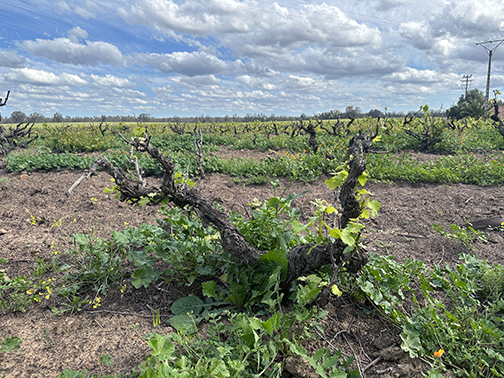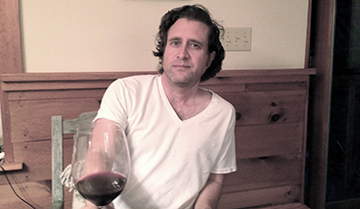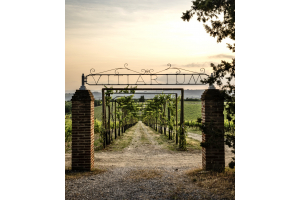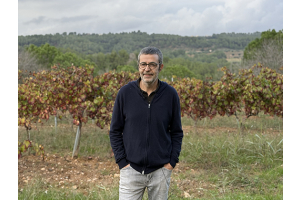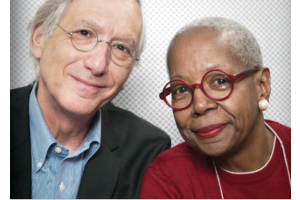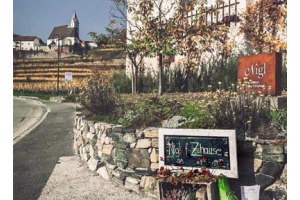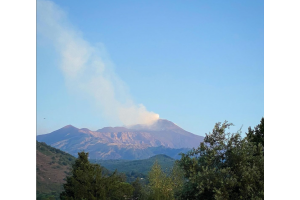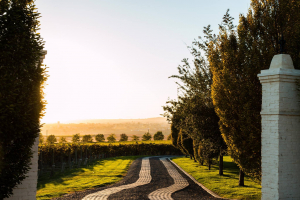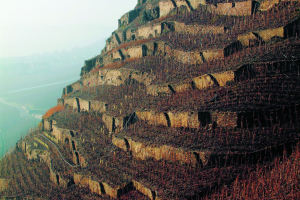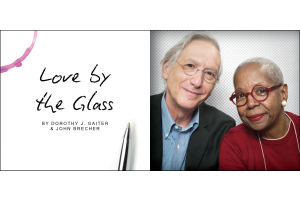“Welcome back to the fight. This time I know our side will win.”
Victor Laszlo, Casablanca 1942
The story of Moroccan wine is steeped in a rich tapestry of history, culture, and contradiction. Its vineyards, sprawling under the hot North African sun, tell a tale that intertwines ancient viticultural traditions with the complexities of colonial legacy. Nowhere is this duality more poignantly mirrored than in the classic 1942 film Casablanca starring Humphrey Bogart and Ingrid Bergman. The movie immortalizes the spirit of resistance during World War II, as Moroccan and French forces unite against Nazi oppression. Yet, beneath the romanticized narrative of defiance lies an uncomfortable truth: France, while aiding the fight against Germany, was itself an occupying power in Morocco, imposing its culture, economy, and, indeed, its wine industry. The film can be interpreted today as an example of Western cultural appropriation, using Moroccan settings and aesthetics while erasing actual Moroccan experiences. And yet, the success of the film has raised international awareness of Morocco, winning three Academy Awards in 1944 and even today consistently ranking high on many lists of the greatest films ever made. It has provided fuel for Morocco's tourism industry which is a key part of the country's economy drawing in 14.5 million visitors in 2023 and accounting for approximately 18% of GDP.
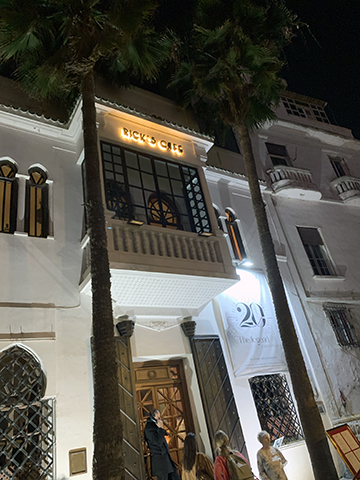 This duality is emblematic of Morocco’s modern wine heritage. The French introduced large-scale wine production during their colonial rule, forever altering the landscape and shaping a key part of the country’s economy. But as Morocco gains recognition for its wines today, questions arise: Can this industry disentangle itself from its colonial roots? And how does it reflect Morocco’s journey toward reclaiming its identity? By examining the cultural and historical intersections of Moroccan wine and its colonial past, we explore how this legacy continues to shape the nation’s wine narrative, a narrative that started in Roman times.
This duality is emblematic of Morocco’s modern wine heritage. The French introduced large-scale wine production during their colonial rule, forever altering the landscape and shaping a key part of the country’s economy. But as Morocco gains recognition for its wines today, questions arise: Can this industry disentangle itself from its colonial roots? And how does it reflect Morocco’s journey toward reclaiming its identity? By examining the cultural and historical intersections of Moroccan wine and its colonial past, we explore how this legacy continues to shape the nation’s wine narrative, a narrative that started in Roman times.
(Rick's Cafe is a popular re-creation of the bar in the film Casablanca)
Ancient Roots and Roman Heritage
In the sun-baked hills near the imperial city of Meknes nestled amongst the Middle Atlas Mountain range in north-central Morocco, where the old Roman ruins of Volubilis still stand, they make wine today, as had been made in Roman times. The Romans, who occupied Morocco in 40 AD, planted the first vines and crushed the first grapes. Excavations at Volubilis uncovered remnants of stone wine presses, fermentation basins and amphorae, suggesting that wine production was significant enough to require long-term storage. As Stephane Marriot, winemaker at Thalvin - Domaine des Ouled Thaleb wines, notes, "Well, before Morocco we often talk about the Egyptians, the Phoenicians, the Romans... traces of winemaking have been found at the Volubilis site near Meknes, an ancient Roman city."
Winemaker Christophe Gribelin of Villa Volubilia, whose estate's name pays homage to these ancient roots, elaborates, "If we talk about history, about the vineyards, the wine in Morocco, we can start with Volubilis… they used to make olive oil and wine, and it’s the first period that we can find traces of wine made in Morocco."
The Romans left Morocco, then known as Mauretania, around 429 CE when the Vandal tribe invaded and took control of the region, effectively ending a rule that had lasted 300 years. The indigenous Berber tribes however, kept the wine tradition alive. They learned from the Romans, then took that knowledge up into their mountain villages. They made wine in their homes, pressing the grapes by hand. It was not winemaking at scale, rather just family tradition. As Gribelin explains, "The Berbers who lived in the mountains in Morocco and traded also with the Romans and they learned about wine from the Romans and continued after the Romans left with not only wine but olive oil and other agricultural products. But it was not an industry, it was mostly making wine for home consumption."
When Islam became predominant in the region (from the 7th century AD onwards), the winemaking tradition declined significantly as Islamic law prohibits alcohol consumption. While it is believed that small pockets of traditional production might have continued to exist post-Roman occupation in remote areas among non-Muslim Berber villages, very little is known about these societies.
The French Protectorate and Industrial Scale Production
The modern era of Moroccan wine began with the French colonization of Northern Africa. Jacques Poulain of La Ferme Rouge provides historical context: "During the Napoleonic era, French settlers introduced vineyards to North Africa, including Algeria, Tunisia, and Morocco, to replace the wine production lost in France due to the widespread infestation of vine-destroying louse phylloxera which decimated European vineyards. These wines were known as 'medicine wines,' and were robust, high in alcohol, and used to enhance French wines."
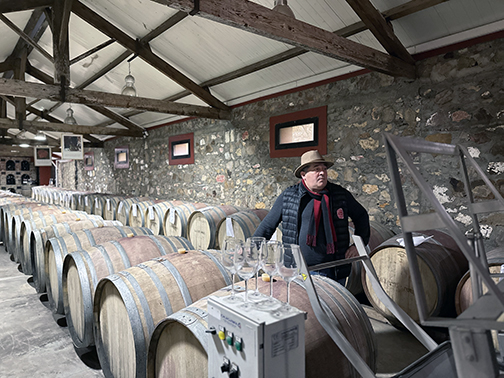 While French influence existed prior, systematic vine planting and wine production really kicked off with the beginning of the French Protectorate in 1912. Guillaume Constant, winemaker at Château Roslane in Meknes (part of the Zniber group of wineries), explains that when the French arrived they brought European grape varieties, leading to the gradual disappearance of native varieties. During this period, Moroccan wine production reached industrial scale, with output ten times greater than current levels.
While French influence existed prior, systematic vine planting and wine production really kicked off with the beginning of the French Protectorate in 1912. Guillaume Constant, winemaker at Château Roslane in Meknes (part of the Zniber group of wineries), explains that when the French arrived they brought European grape varieties, leading to the gradual disappearance of native varieties. During this period, Moroccan wine production reached industrial scale, with output ten times greater than current levels.
(Jacques Poulain in the barrel room at La Ferme Rouge)
Post-Independence Decline and Revival
The wine industry nearly died in 1956 when the French Protectorate ended and Europe closed its doors to Moroccan wine. As Christophe Gribelin recounts, "After the French period, and the independence, the agricultural and the wine industry changed, because first of all, they had an issue with the European market. The European market stopped importing wine from Morocco and also from Algeria." Many French settlers, who had been instrumental in developing the country's wine industry, left Morocco after independence. Their departure left vineyards without experienced management and disrupted the production infrastructure. The introduction and formalization of the Appellation d'Origine Contrôlée (AOC) system in France also had a significant indirect impact on the decline of French wine imports from Morocco, especially after 1956 as French officials refused to certify producers that utilized Moroccan wine in their blends.
Modern Renaissance and Royal Support
However, one figure emerged as crucial to maintaining Morocco's viticultural heritage. Stephane Marriot explains, "It was our dear president and founder, Mr. Brahim Zniber, who almost single-handedly revived this viticulture in Morocco after the departure of the French." Zniber began his career in wine production in 1956, when he purchased 740 hectares in the Meknes area. Two years later he was granted 1,100 hectares by King Hassan II, mainly landholdings that were restituted from French colonists in the wake of Morocco's independence. Guillaume Constant adds that Zniber's estates now represent "80% to 85% of Moroccan wine production, amounting to 24 million bottles per year."
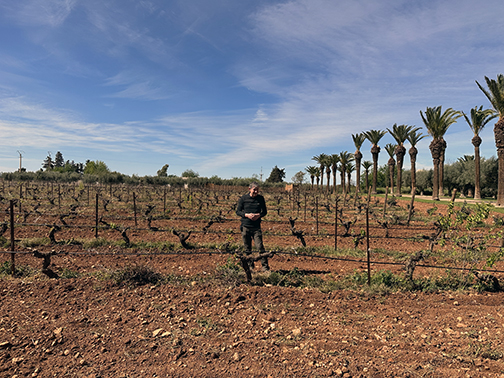 The 1990s saw another significant shift when King Hassan II recognized the need to develop Morocco's wine industry. Despite Morocco being a Muslim-majority country, the monarchy took a pragmatic approach. As Guillaume Constant notes, "King Hassan II realized that the country wasn't producing enough wine, so he brought in groups like Groupe Castel and Bernard Magrez to help develop the industry." Philippe Magrez of famed Bordeaux producer Bernard Magrez spoke about his family’s entry into the Moroccan wine market: “In the 1990s, we rented over 1,000 hectares of land and planted classic varieties like Carignan, Grenache, and Syrah. Despite the hot climate, we produced excellent wines, some of which were sold exclusively in Morocco.”
The 1990s saw another significant shift when King Hassan II recognized the need to develop Morocco's wine industry. Despite Morocco being a Muslim-majority country, the monarchy took a pragmatic approach. As Guillaume Constant notes, "King Hassan II realized that the country wasn't producing enough wine, so he brought in groups like Groupe Castel and Bernard Magrez to help develop the industry." Philippe Magrez of famed Bordeaux producer Bernard Magrez spoke about his family’s entry into the Moroccan wine market: “In the 1990s, we rented over 1,000 hectares of land and planted classic varieties like Carignan, Grenache, and Syrah. Despite the hot climate, we produced excellent wines, some of which were sold exclusively in Morocco.”
(Guillaume Constant in the vinyards of Chateau Roslane)
The wine industry further evolved under the leadership of the son of Hassan II, the current king Mohamhad VI who ascended the throne in 1999. He adopted a more pragmatic approach balancing economic benefits with cultural sensitivity which included allowing under certain circumstances for foreign companies to purchase vineyard land, rather than leasing which was the only venue allowable under his father. This shift aligns with Mohammed VI's broader economic liberalization policies and efforts to attract foreign investment across multiple sectors of the Moroccan economy.
This royal support helped create what Christophe Gribelin describes as "a pretty open-minded country." He elaborates: "Morocco is a Muslim country, but tolerance is really part of this country. You have a strong Jewish tradition here with the cooking, with the people. And tourists are welcome in Morocco."
Contemporary Production and Terroir
Today's Moroccan wine industry is characterized by diverse terroirs and adaptability to challenging conditions. Stephane Marriot describes the variety: "In Morocco, we are fortunate to have very diverse terroirs. Most of the vineyards are clay-limestone but with different components, depending on the composition of clay or sand in the soil."
(Old bush vine Syrah at the Thalvin Winery)
Climate in the different regions also varies greatly. Meknes, the most significant wine region, is 1,300–2,300 feet above sea level and has a Mediterranean climate with continental influences. The proximity to the Middle Atlas Mountains helps regulate the climate, offering a cooling effect that extends the growing season. In contrast, Essaouira, another of Morocco’s important wine regions located in southwestern Morocco, is coastal, rarely exceeding 300 feet in altitude, hot and arid and moderated by Atlantic breezes.
The wine industry has adapted to local conditions while maintaining high standards. Morocco has established its own appellation system, with both AOGs (Guaranteed Designations of Origin) and AOCs (Controlled Designations of Origin). Château Roslane created the country's first AOC in 1998, adapting French standards to the local context.
Climate Change and Adaptation
To a greater degree than their neighbors to the north in Europe, modern Moroccan winemakers face significant challenges from climate change, but their experience might prove invaluable for the global wine industry. As Christophe Gribelin observes, "Today, Moroccan wine is already the future of European wine... the techniques, the climate, the issues that we are facing are something that, certainly in Spain, that they will face or in France as well." Gribelin sees Morocco gradually exploring higher altitude vineyards in the future as a way to mitigate against climate change. “To me, attitude should be a key focus to think about. That's why we are already at 800 meters (2,600 feet) altitude and maybe we will go higher.”
Stephane Marriot describes their proactive approach at Thalvin - Ouled Thaleb: "We have a research unit, and we're also developing viticulture… to test many varieties that would be better able to withstand our current climate change challenges. So less and less water, of course, more and more heat."
Grape Varieties and Innovation
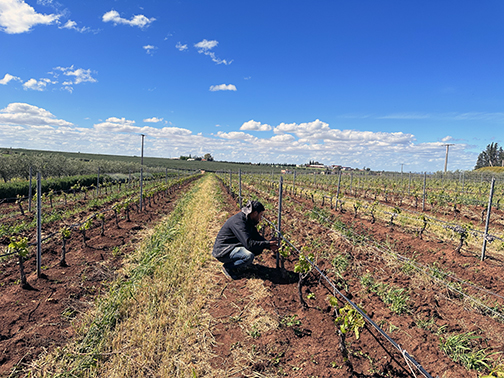 While the modern Morocco wine industry has for the moment lost its indigenous grape varieties, it has found success with certain imported varieties. Syrah and Cabernet Franc, in particular, thrive in the Moroccan climate. Stephane Marriot notes, "The Syrah grape variety is, I think, very well adapted to our terroir, our climate and our way of doing things."
While the modern Morocco wine industry has for the moment lost its indigenous grape varieties, it has found success with certain imported varieties. Syrah and Cabernet Franc, in particular, thrive in the Moroccan climate. Stephane Marriot notes, "The Syrah grape variety is, I think, very well adapted to our terroir, our climate and our way of doing things."
(Yassine Dahouri in the vineyards of Domaine de Baccari)
Today there exist several examples of Syrah made from old vineyards that are starting to get international recognition for Morocco. In 2005 Alain Graillot, a renowned winemaker in the Northern Rhône, the spiritual home of Syrah, was on a bicycle tour of Morocco when he came across some very old Syrah vineyards. He tracked down the winemaker at the Thalvin winery (at the time Jacques Poulain) and tasted the wines made from those grapes. Impressed, Graillot struck an agreement with Thalvin to collaborate on a project that eventually became the Tandem brand. The wine is based on the same old, organically farmed Syrah vineyards he rode by on his cycling trip, many of which were planted in the 1950s (Tandem is known as Syrocco in the USA). Although Graillot passed away in 2022, the Graillot family is still involved in the Tandem brand and visits twice a year to conduct tastings with the Thalvin team.
Agronomist Yassine Dahouri of Domaine de Baccari, a boutique producer in the Meknes region is a champion of Cabernet Franc: “Cabernet Franc is our pride here in the Domaine de Baccari field. With that we make the top of the range wine. It is a grape variety that is late to ripen, it is the last grape variety that we pick.”
Other successful varieties include Carignan, Grenache, and more recently, drought-resistant varieties like Tempranillo from Spain. However, some traditional European varieties struggle. As Guillaume Constant explains, "Syrah thrives here, but Cabernet struggles, and Merlot has been almost entirely phased out due to climate change."
Organic viticulture is an important part of modern winemaking in Morocco with most of the producers we talked to committed to using biological treatments in the vineyards. Dahouri talks about his approach to farming. “We treat with flowers, with rosemary, with chamomile, we put compost and seeds on the rows to enrich the soil, to leave organic matter on the rows and make green fertilizers. For example, for phytosanitary treatments, we always stay on reasonable treatments, with copper we respect the international dosage for copper and sulfur. And the other treatments are 100% organic. We make kaolin to protect against sunburns, and we put in chamomile teas and other treatments. We do everything that is organic for our vineyards.”
Both Poulian and Constant spoke of the existence of experimental vineyards, where agronomists are working on tests with indigenous grape varieties. The goal of these projects is to find varieties that can stand up to climate change, and grapes that are native to the region offer some hope. So while the current generation of Moroccan wine has a French twist, there remains a possibility that in the future some Moroccan wine will be made with grapes not dissimilar to what the Romans vinified with many centuries ago.
Wine's Place in Modern Moroccan Society
Perhaps most fascinating is how wine production fits into contemporary Moroccan society. Stephane Marriot challenges common assumptions: "A lot of people from outside, who don't live in Morocco, often ask me how much I export and how much is drunk locally... they're often astonished by my answer, because almost all our production is consumed locally."
 He notes an evolution in local wine culture: "And I find that local people's approach to this type of consumption is changing over the years. And there's a growing interest around wine. Really, there's this approach to tasting, to quality and to enjoying wine."
He notes an evolution in local wine culture: "And I find that local people's approach to this type of consumption is changing over the years. And there's a growing interest around wine. Really, there's this approach to tasting, to quality and to enjoying wine."
(Kutubiyya Mosque in Marrakesh, founded in 1147)
Jacques Poulain addresses the delicate balance of producing wine in a Muslim-majority country: "The costs of production are as high—if not higher—than in France...unlike Europe, we don't have subsidies for planting or harvesting. None of that exists here." However, he emphasizes the positive social and economic impact: "For our village, our presence has been transformative… it's not just about producing wine but creating a community and a sustainable way of working." The wine sector in Morocco is estimated to support 750,000 jobs directly and many more indirectly.
Tourism and Cultural Exchange
Moroccan wine has become an important part of the country's tourism offering. Moroccan cities such as Marrakech, Casablanca, Fez, Tangier, Essaouira, and Chefchaouen have international reputations for hospitality. Morocco is a home to some of the world’s most exclusive hotel chains including the Four Seasons, Ritz Carlton, Mandarin Oriental and many exclusive boutique hotels. It is also widely celebrated for its culinary traditions, and offers world class food that reflects the country’s unique geographical position as a crossroads between Europe, Africa, and the Arab world. Christophe Gribelin explains how wine enhances the visitor experience: "When you eat a tagine or couscous in an environment where you have the sun, and when you have the water, you have the freshness and a lot of aroma. It's really interesting to pair the wine with all this rich flavor." A Moroccan meal paired with a bottle of locally crafted wine proves the adage that the whole is truly greater than the sum of its parts.
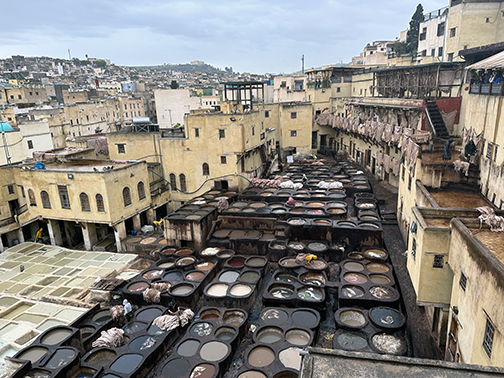 The future of Moroccan wine appears promising, despite challenges. The industry has shown remarkable adaptability, from ancient Roman times through the French Protectorate and into the modern era. Today's winemakers are focusing on sustainability, quality, and adaptation to climate change.
The future of Moroccan wine appears promising, despite challenges. The industry has shown remarkable adaptability, from ancient Roman times through the French Protectorate and into the modern era. Today's winemakers are focusing on sustainability, quality, and adaptation to climate change.
(The Chouara Tannery in Fez, the round stone vessels filled with dye or white liquids for softening the hides)
As Stephane Marriot reflects, "It's my job to give pleasure with wine. And that's really what I feel around me." This simple statement perhaps best captures the spirit of Moroccan wine: a product that transcends cultural boundaries to bring joy and connection, while respecting both tradition and innovation.
A Legacy Reclaimed
Just as Rick's Café in Casablanca transformed from a symbol of colonial presence to a beacon of resistance, Morocco's wine industry has undergone its own metamorphosis. The iconic line from the film—"Welcome back to the fight"—resonates with Morocco's journey to reclaim its viticultural heritage from colonial imposition and forge a uniquely Moroccan identity.
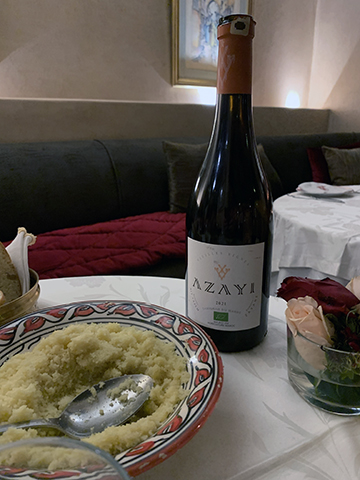 The film Casablanca itself serves as a powerful metaphor for this evolution. Though created by Hollywood as a romanticized portrayal of Morocco through Western eyes, it has in its own way had a positive impact in raising awareness of Morocco internationally. Similarly, wine—introduced as a colonial enterprise—has been reclaimed and reimagined by Moroccan vintners who blend international techniques with local knowledge, terroir, and cultural sensibilities.
The film Casablanca itself serves as a powerful metaphor for this evolution. Though created by Hollywood as a romanticized portrayal of Morocco through Western eyes, it has in its own way had a positive impact in raising awareness of Morocco internationally. Similarly, wine—introduced as a colonial enterprise—has been reclaimed and reimagined by Moroccan vintners who blend international techniques with local knowledge, terroir, and cultural sensibilities.
(Azayi is a 100% Carignan made from old vines and served here with with couscous)
Today's Moroccan winemakers have taken what was once imposed and transformed it into something authentically Moroccan. They navigate the delicate balance between honoring the technical knowledge inherited from colonial times while severing the exploitative aspects of that relationship. The result is not merely a continuation of French viticultural traditions but something distinctly North African—wines that speak of Morocco's unique climate, soil, and cultural synthesis.
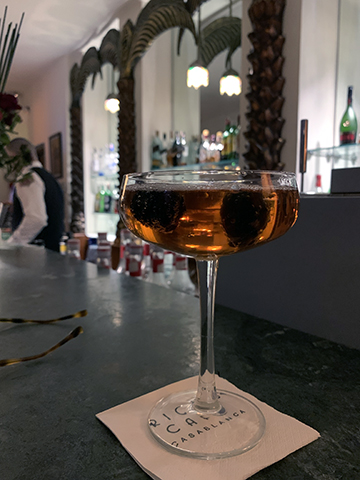 As climate change reshapes traditional wine regions globally, Morocco stands not as a colonial outpost but as a modern soldier on the front line. The techniques developed here may well become the blueprint for winemaking's future as European regions begin to face the challenges that Moroccan vintners have managed for decades.
As climate change reshapes traditional wine regions globally, Morocco stands not as a colonial outpost but as a modern soldier on the front line. The techniques developed here may well become the blueprint for winemaking's future as European regions begin to face the challenges that Moroccan vintners have managed for decades.
Like the unexpected alliances formed in Rick's Café Américain, Morocco's wine industry represents a complex reconciliation of seemingly contradictory elements—Islamic cultural tradition alongside viticultural heritage, colonial history alongside indigenous innovation. The story of Moroccan wine, much like the tale told in Casablanca, reminds us that from the most complicated and even painful histories can emerge something worth preserving, something that transcends its origins to become a symbol not of subjugation but of resilience and cultural renaissance.
"Here's looking at you, kid"—a toast not to what was imposed, but to what has been reclaimed.
